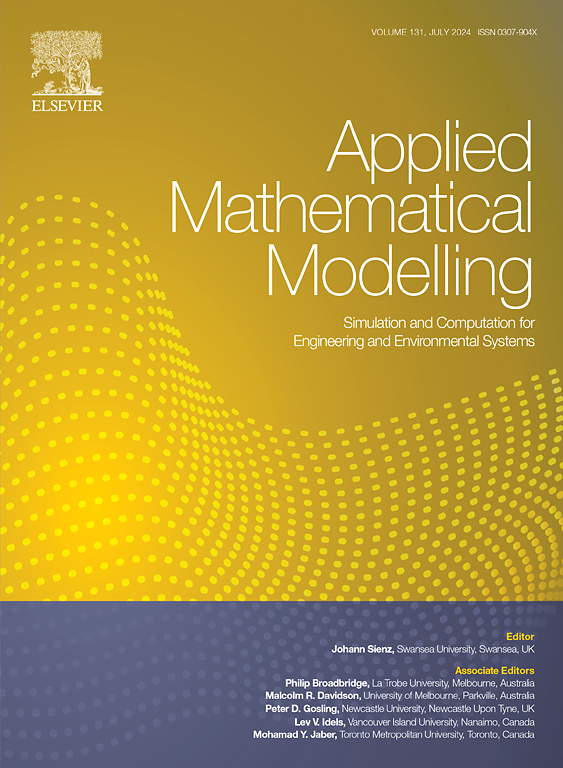Scattering of Rayleigh wave by inclined surface open cracks: Numerical simulations based on reciprocity theorem and verification using finite element method
IF 4.4
2区 工程技术
Q1 ENGINEERING, MULTIDISCIPLINARY
引用次数: 0
Abstract
Surface cracks typically exhibit a range of characteristics, including varying depths and inclined angles. Investigating the interaction between ultrasonic surface waves and these cracks is crucial for the non-destructive evaluation of their properties. In this work, the amplitudes of Rayleigh waves scattered in the far field by inclined surface open cracks with depths exceeding the wavelength are investigated in a two-dimensional plane. An integral equation, derived from the reciprocity theorem, is formulated for the scattered Rayleigh waves, which is equivalent to the radiated fields from forces and tractions generated by the incident waves at the surface of the crack. Within this integral equation framework, the crack opening displacements caused by the incident Rayleigh waves are determined by solving singular integral equations based on Chebyshev's theorem. An oblique coordinate system is introduced to obtain solutions for the scattered Rayleigh waves generated by inclined cracks. Numerical solutions for the scattered Rayleigh waves are provided, employing reflection and transmission coefficients to investigate the influence of crack length, inclined angle, and depth on wave scattering. It is found that the transmission coefficients of Rayleigh waves exhibit high sensitivity to crack depth, whereas the reflection coefficients depend on both the crack depth and its inclined angle. The finite element method has been used to validate the simulation results obtained from the proposed theory. This theory can further enhance the quantitative assessment of surface cracks.
倾斜表面开口裂缝对瑞利波的散射:基于互易定理的数值模拟和有限元法验证
表面裂缝通常表现出一系列特征,包括不同的深度和倾斜角。研究超声表面波与这些裂纹之间的相互作用对于无损评价其性能至关重要。本文在二维平面上研究了深度超过波长的倾斜表面开放裂纹在远场散射的瑞利波振幅。由互易定理导出了散射瑞利波的积分方程,该方程等价于入射波在裂纹表面产生的力和牵引力的辐射场。在该积分方程框架内,基于切比雪夫定理,通过求解奇异积分方程来确定入射瑞利波引起的裂纹张开位移。引入斜坐标系求解斜裂缝产生的散射瑞利波。给出了散射瑞利波的数值解,利用反射系数和透射系数研究了裂缝长度、倾斜角度和深度对波散射的影响。研究发现,瑞利波的透射系数对裂缝深度有较高的敏感性,而反射系数则与裂缝深度和裂缝倾斜角有关。用有限元方法对所提出理论的仿真结果进行了验证。该理论可以进一步提高表面裂纹的定量评价。
本文章由计算机程序翻译,如有差异,请以英文原文为准。
求助全文
约1分钟内获得全文
求助全文
来源期刊

Applied Mathematical Modelling
数学-工程:综合
CiteScore
9.80
自引率
8.00%
发文量
508
审稿时长
43 days
期刊介绍:
Applied Mathematical Modelling focuses on research related to the mathematical modelling of engineering and environmental processes, manufacturing, and industrial systems. A significant emerging area of research activity involves multiphysics processes, and contributions in this area are particularly encouraged.
This influential publication covers a wide spectrum of subjects including heat transfer, fluid mechanics, CFD, and transport phenomena; solid mechanics and mechanics of metals; electromagnets and MHD; reliability modelling and system optimization; finite volume, finite element, and boundary element procedures; modelling of inventory, industrial, manufacturing and logistics systems for viable decision making; civil engineering systems and structures; mineral and energy resources; relevant software engineering issues associated with CAD and CAE; and materials and metallurgical engineering.
Applied Mathematical Modelling is primarily interested in papers developing increased insights into real-world problems through novel mathematical modelling, novel applications or a combination of these. Papers employing existing numerical techniques must demonstrate sufficient novelty in the solution of practical problems. Papers on fuzzy logic in decision-making or purely financial mathematics are normally not considered. Research on fractional differential equations, bifurcation, and numerical methods needs to include practical examples. Population dynamics must solve realistic scenarios. Papers in the area of logistics and business modelling should demonstrate meaningful managerial insight. Submissions with no real-world application will not be considered.
 求助内容:
求助内容: 应助结果提醒方式:
应助结果提醒方式:


